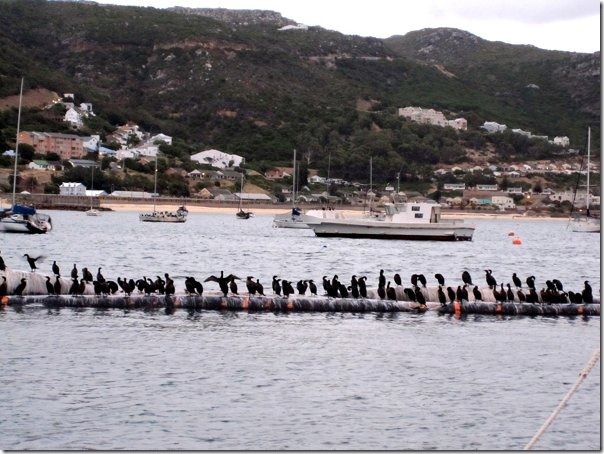.....and a Jump

JJMoon Diary
Barry and Margaret Wilmshurst
Mon 11 Feb 2013 12:18
|
We got the timing right again and completed the 530 passage from East
London to Simon’s Town in fine fettle. The first few hours and the last
few were the most interesting. We headed straight out into the current on
Tuesday afternoon in light headwinds. Motor-sailing south and west for 15
hours at between 10 and 12 knots over the ground in flat seas was a most
encouraging start. For the next couple of days we sailed or motored
comfortably in very light zephyrs, then on entry to False Bay the wind picked up
dramatically and hurled us in towards Simon’s Town with gusts of over 40
knots. Kind friends were ready to turn out and take our lines as we
attempted to slot into the marina berth but, discretion being the better part of
valour, we anchored for the night just outside. Even that was a little
stimulating but the black mud was thick and grabbed our anchor reassuringly,
first time. Early Saturday morning we motored into our allotted place in a
flat calm and pouring rain. We are certainly back into temperate
climes.
Some 100 miles south-east of here, as we passed south of Cape Agulhas, we
left the Indian Ocean and entered the Atlantic. Most of us cruisers think
this a highly significant milestone; the Indian Ocean is treated harshly in many
a blog and is compared unfavourably with other seas. There is something in
it – the south-east trade winds can reach a consistent 25 to 30 knots for days
on end while at the same time there can be a large swell on the beam rolling up
from left-over gales in the “Roaring Forties” to the south. At its worst
this combination can be most uncomfortable. But from our experience the
bad reputation is a little over-blown; conditions are not always so demanding
and our own crossing was not arduous. Our visits to Cocos Keeling,
Rodrigues and Mauritius were most enjoyable. On the other hand the Agulhas
current off the east coast of South Africa is a genuine horror. The charts
and Admiralty Sailing Directions are full of dire warnings. “Abnormal
waves” of 20 metres’ height followed by deep troughs have been recorded by
serious institutes and large vessels have foundered. Timing is
everything. A well-found boat that left Durban a day before us was knocked
down and suffered slight damage in moderate conditions. On the other hand
in the right circumstances the current can be a great blessing. Hundreds
of miles covered in half the usual time is no end of a morale booster. The
winds being very light we shaped our course to keep in the current for as long
as possible, and it seemed to pay off.
The False Bay Yacht Club is tucked in behind the Simon’s Town naval
base. It is a very friendly, well organised club with good marina berths
managed by a separate company. We were immediately made welcome and may be
here for two to three weeks. We have been introduced to some of the local
facilities and have had an initial look round. Simon’s Town is an
attractive place reminiscent of a Cornish fishing village, built in Victorian
times, now gentrified and smartened up for tourists. Not so tidy though -
I doubt they have Conservation Areas and Areas of Outstanding Natural Beauty
around here. Nevertheless, we expect to feel very much at home and, when
the time comes, be reluctant to leave. Our next stop will be in Cape Town,
round the other side of the Cape of Good Hope, where we shall clear out of South
Africa and head north towards Namibia and the wide Atlantic.
Part of the marina and the anchorage at False Bay Yacht Club, Simon’s Town
Roosting room at a premium on the wave-breaker boom. There is fierce competition for places each night. |

